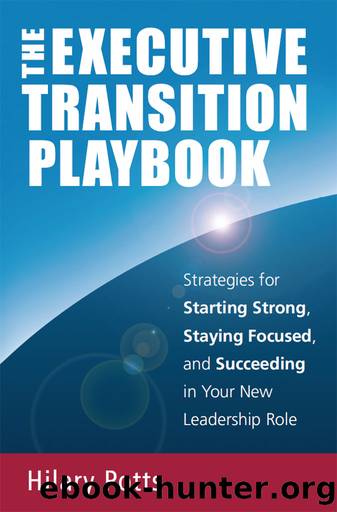The Executive Transition Playbook: Strategies for Starting Strong, Staying Focused, and Succeeding in Your New Leadership Role by Hilary Potts

Author:Hilary Potts [Potts, Hilary]
Language: eng
Format: epub
Publisher: The HAP Group, LLC
Published: 2015-09-21T21:00:00+00:00
Chapter 14
Listening: The Art of Engagement
We have two ears and one mouth and we should use them proportionally.
– Susan Cain
Listen, Listen, and Listen Some More
According to Julian Treasure, an expert in listening techniques, we spend roughly 60 percent of our communication time listening, but we retain only about 25 percent of what we hear. He says we are losing our ability to listen. The lack of good listening in business can cause issues to arise when you are trying to build relationships, help others understand business concepts, and lead your fellow workers.
When we actively listen, people feel heard. You create a dialogue and mutual understanding. When you become more conscious about your listening, your understanding and engagement increase significantly.
Unfortunately, listening can be a difficult skill for leaders to learn, since they are accustomed to directing the conversation. Yet, transitions require careful listening. You will be given a lot of information from multiple sources and will need to find a way to sort through it all. You may even have a tendency to filter out messages that do not fit your assumptions. So make every effort to hear messages that disagree with your orientation, as well as those that support your plans.
Listening starts with being able to listen to oneself. When we can take a pause from our busy lives and sit in silence, we can learn to listen to ourselves without judgment or the need to change or fix anything. We are then able to listen to the rest of the world.
Conscious Listening
To bring focus to the topic and give keen attention to the person talking, practice conscious listening. During this process, the listener practices listening without feeling the need to respond. Using conscious listening, the leader can then be present, with attention fully on the speaker. The listener thus creates a safe environment for the speaker to share information.
Conscious listening also allows us to be aware of our thoughts, feelings, and beliefs. It gives us a way to put into perspective the information we receive from others, and to thoughtfully prepare how we share comments and feedback. When we listen consciously, we can gain the benefit of what people are actually trying to communicate. Conscious listening is first about listening and then about absorbing. You can then respond thoughtfully to the speaker.
Leaders can become enamored with their own solutions and shut off input from others. When we believe our ideas are better than those of others, we put ourselves and the business at risk, because we may not be looking objectively at the full situation. Our business judgment can become clouded, and we are apt to make mistakes. Conscious listening can pull us back to the present to hear what is really being said.
Practice Listening
Leaders can become so expert at filtering outside noise that they may actually stop listening to the inputs. Such leaders become deaf to objections, whether stated or hinted at, and search to hear only things that match their own thinking. They can also become impatient with long explanations, if they are accustomed to receiving information only in sound bites.
Download
This site does not store any files on its server. We only index and link to content provided by other sites. Please contact the content providers to delete copyright contents if any and email us, we'll remove relevant links or contents immediately.
Hit Refresh by Satya Nadella(9038)
The Compound Effect by Darren Hardy(8808)
Change Your Questions, Change Your Life by Marilee Adams(7635)
Nudge - Improving Decisions about Health, Wealth, and Happiness by Thaler Sunstein(7615)
The Black Swan by Nassim Nicholas Taleb(7010)
Deep Work by Cal Newport(6879)
Daring Greatly by Brene Brown(6444)
Rich Dad Poor Dad by Robert T. Kiyosaki(6401)
Principles: Life and Work by Ray Dalio(6209)
Man-made Catastrophes and Risk Information Concealment by Dmitry Chernov & Didier Sornette(5921)
Playing to Win_ How Strategy Really Works by A.G. Lafley & Roger L. Martin(5916)
Digital Minimalism by Cal Newport;(5663)
Big Magic: Creative Living Beyond Fear by Elizabeth Gilbert(5610)
The Myth of the Strong Leader by Archie Brown(5425)
The Slight Edge by Jeff Olson(5346)
Discipline Equals Freedom by Jocko Willink(5285)
The Motivation Myth by Jeff Haden(5156)
Stone's Rules by Roger Stone(5026)
The Laws of Human Nature by Robert Greene(4996)
